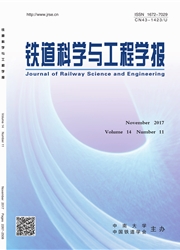

 中文摘要:
中文摘要:
提出一种基于连续跳车激振的大跨度桥梁阻尼识别的强迫振动法。该方法利用“共振”原理,让车辆以合适速度连续驶越障碍物使主梁经受与桥梁某阶频率相同的周期性脉冲荷载,使桥梁产生较大振幅的振动,从而增强测试信号的信噪比。给出基于连续跳车激振的结构阻尼比识别的基本理论,并以一大跨度悬索桥为例进行动力学仿真。复模态分析表明,当车辆固有频率是桥梁某阶受测模态频率的5倍以上时,车辆振动对受测模态阻尼比影响很小。采用连续跳车激励,当相邻障碍物的间隔?x与行车速度V和受测模态的固有周期T之间满足?x=VT,可以激振起桥梁大幅振动。当噪信比较小时,可以较准确地识别1阶反对称模态阻尼比;随着信噪比的降低,阻尼比识别结果精度有所降低。
 英文摘要:
英文摘要:
In this study,a new method termed as continuous vehicle bumping excitation method that was based onresonance principle was proposed in this paper.A bridge will be set into resonance if the bridge is subjected tomultiple impulses induced by a series of obstacles evenly distributed along the deck and the impulse frequencyequals to the natural frequency of the attendant mode.The purpose of the excitation is to enhance thesignal-to-noise ratio of measured output,and therefore improving identification accuracy of modal damping ratio.The basic theory of structural damping ratio identification by continuous vehicle bumping excitation method waspresented.The validity of the proposed method was demonstrated by numerical simulation of a long-spansuspension bridge with a special reference to the first anti-symmetrical vertical mode,and the effects of testvehicle on modal properties in particular on modal damping ratio of target modes were examined throughcomplex modal analysis.It is shown that the modal damping ratio for the tested mode is unaffected if the modalfrequency of the vehicle is about5times larger than that of the tested mode of the bridge.The modal damping canbe reliably identified even the excitation and measured response are polluted with10%noise.
 同期刊论文项目
同期刊论文项目
 同项目期刊论文
同项目期刊论文
 期刊信息
期刊信息
